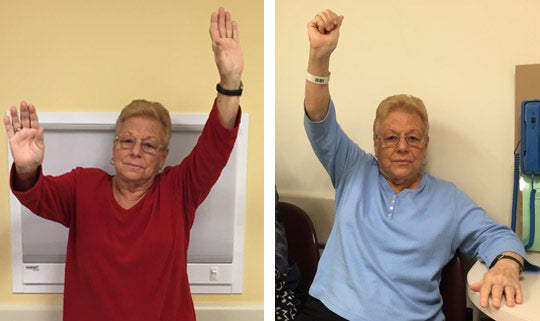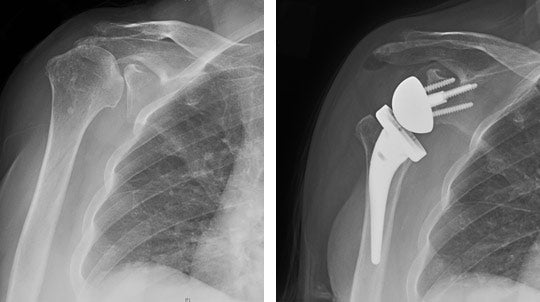Osteoarthritis, or "wear and tear" arthritis, is a common degenerative disease that can affect any joint in the body, causing inflammation with pain and stiffness. As the body ages, osteoarthritis is quite common; it usually effects people over age 50. There are two joints in the shoulder that can be affected – one where the upper arm bone (humerus) fits into the rounded socket in the shoulder blade (scapula); the other where the collarbone (clavicle) meets the shoulder blade; both can lose the cartilage that protects the bone, causing the bones to rub together.
Diagnosing Osteoarthritis of the Shoulder
Physical Exam
Your physician will ask you a series of questions and is likely to do a physical exam. The physical exam will including examining any specific areas of concern, especially as they relate to the reason for your visit to the office.
X-Rays
A form of electromagnetic radiation with very high frequency and energy. X-rays are used to examine and make images of things such as the bones and organs inside the body.
MRI
This test uses a magnetic field, radiofrequency pulses, and a computer to produce detailed images of body structures in multiple places. You may be injected with a contrast agent for better imaging, and you will most likely lie on a moving table as pictures are taken. MRI is a more detailed tool than x-ray and ultrasound and for certain organs or areas of the body, it provides better images than CT. MRI may not be recommended if you have a pacemaker or other metal implants.
Blood Tests
A common tool for disease screening, blood tests provide information about many substances in the body, such as blood cells, hormones, minerals, and proteins.
Treatments for Osteoarthritis of the Shoulder
Nonsteroidal anti-inflammatory drugs (NSAIDs)
A class of medications, including but not limited to aspirin, naproxen, and ibuprofen, that are used for reducing pain and redness, swelling, and heat (inflammation) in arthritis and other painful inflammatory disorders.
Physical Therapy
Sometimes referred to simply as "PT," this is a type of rehabilitative treatment that uses specially designed exercises and equipment to help patients preserve, regain, or improve their physical abilities following injury, disability, disease, or surgery. Physical therapy can include therapeutic exercise, massage, assistive devices, and patient education and training.
Activity Modification
Physicians may prescribe general lifestyle changes to a patient, in order to help relieve the symptoms of their condition and improve their overall physical function and well-being. Depending on the medical condition being treated, activity modification may include: decreasing or increasing one's level of physical activity; added rest; beginning a new activity or exercise program; changing sleep habits; or modifying one's physical environment at home, in their vehicle, or at work.
Corticosteroid injections
Also known as cortisone shots, these are injections that may help relieve pain and inflammation in a specific area of the body. Cortisone shots are most commonly given into joints — such as the ankle, elbow, hip, knee, shoulder, spine, and wrist.
Glucosamine & Chondroitin Sulfate
Glucosamine is found naturally in the body. It stimulates the formation and repair of articular cartilage. Over-the-counter supplements come from animal sources. Chondroitin sulfate is another natural substance found in the body. It prevents other body enzymes from degrading the building blocks of joint cartilage.
Surgery for Osteoarthritis of the Shoulder
For patients whose condition has not responded to nonsurgical treatments, there are several different shoulder surgery options. For milder arthritis cases, arthroscopy may be performed. This involves the surgeon inserting a small camera, called an arthroscope, into the shoulder joint. The camera displays pictures on a television screen, and the surgeon uses these images to guide miniature surgical instruments. Arthroscopy allows for only very small incisions (cuts), due to the very thin pieces of equipment that are used. For more advanced cases, shoulder joint replacement (arthroplasty) may be performed. During shoulder joint replacement, the damaged parts of the shoulder are removed and replaced with an artificial component, called a prosthesis. Replacement surgery techniques include hemiarthroplasty, total shoulder arthroplasty, resection arthroplasty, and reverse total shoulder arthroplasty. The patient's surgeon can discuss which option is best for each individual's case.


BMC offers specialized expertise in reverse shoulder surgery, which can result in less pain and greater range of motion for patients with shoulder arthritis called "cuff tear arthropathy." These photos show pre-op and post-op x-rays and photos of BMC patient Mary Capo, 74, of Saugus, MA. After suffering with pain in her right shoulder for more than four years, Mary underwent reverse shoulder surgery with Xinning "Tiger" Li, MD, at BMC. Shown here at two months post-surgery, Mary is able to once again lift her right shoulder and remarked that she is no longer experiencing any pain or problems sleeping. "I'm very happy with the surgery," Mary said. "I'm glad I had it done, and would do it again if I had to!" Mary also said that she would "absolutely recommend (reverse shoulder surgery) to others" who may be considering the procedure.
Departments and Programs Who Treat This Condition
Orthopedic Surgery
Physical and Occupational Therapy
Musculoskeletal Medicine and Pain Management Program
 en
en 
 Français
Français Deutsch
Deutsch Italiano
Italiano Español
Español Tiếng Việt
Tiếng Việt Kreyol ayisyen
Kreyol ayisyen